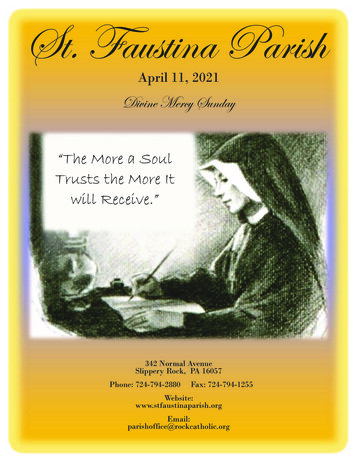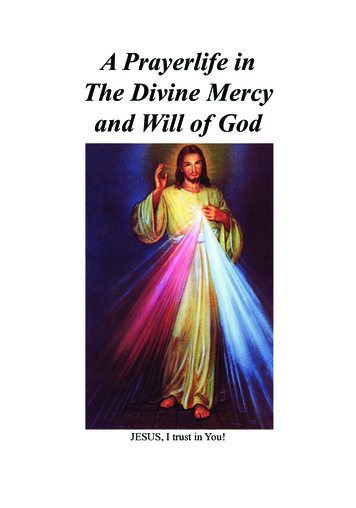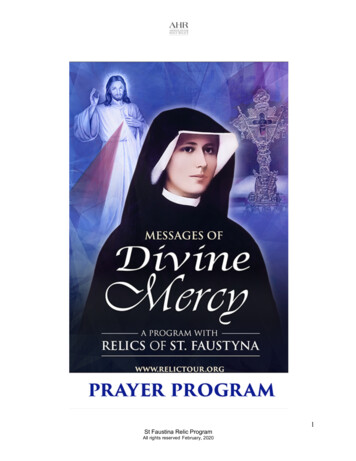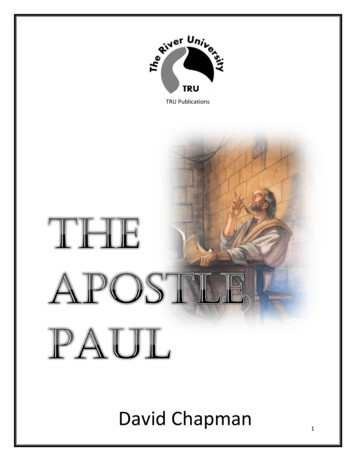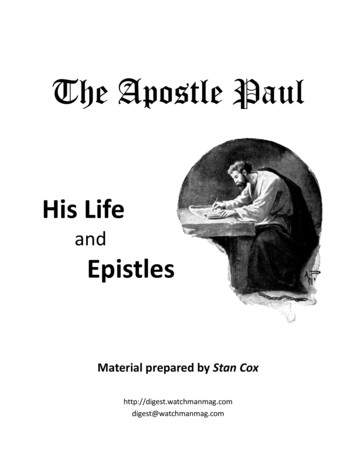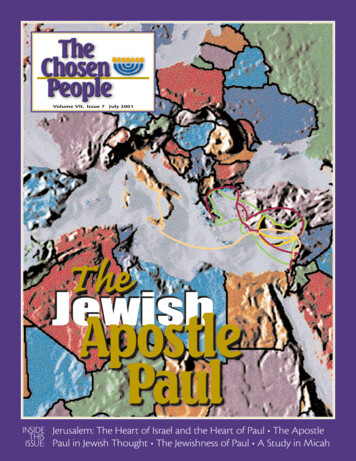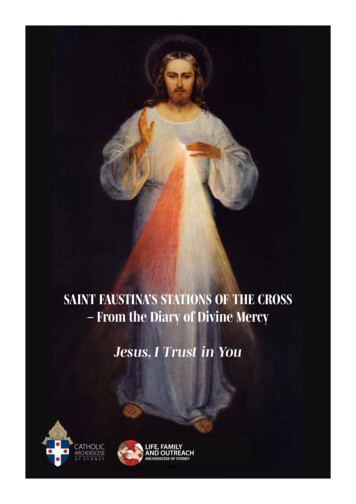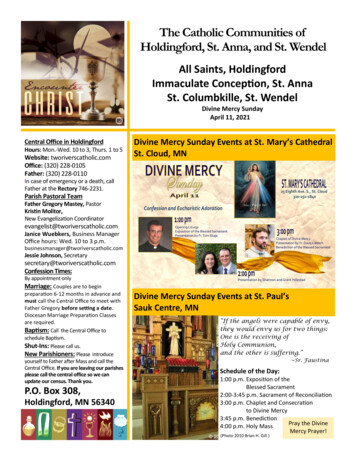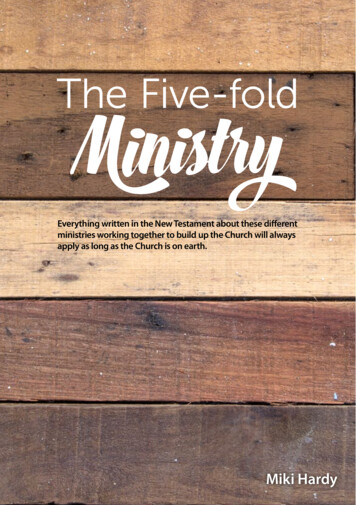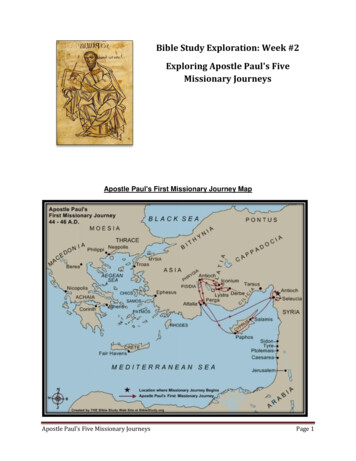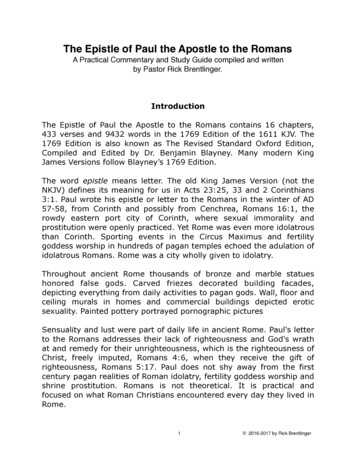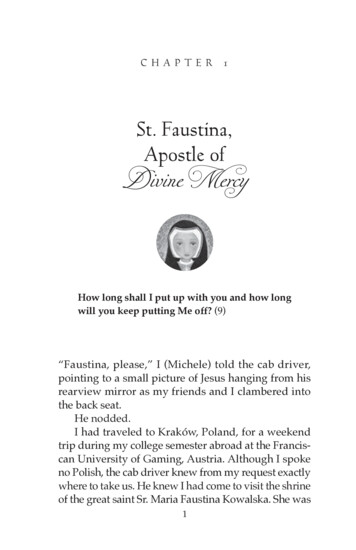
Transcription
CHAPTER1St. Faustina,Apostle ofDivine MercyHow long shall I put up with you and how longwill you keep putting Me off? (9)“Faustina, please,” I (Michele) told the cab driver,pointing to a small picture of Jesus hanging from hisrearview mirror as my friends and I clambered intothe back seat.He nodded.I had traveled to Kraków, Poland, for a weekendtrip during my college semester abroad at the Franciscan University of Gaming, Austria. Although I spokeno Polish, the cab driver knew from my request exactlywhere to take us. He knew I had come to visit the shrineof the great saint Sr. Maria Faustina Kowalska. She was1
2Divine MercyforMomsa young Polish religious sister who in the 1930s experienced extraordinary visions of Jesus and his mother.Although Faustina was not very well known in theUnited States at the time of my visit to Kraków, shewas widely celebrated in Poland.Hanging from the cab’s mirror was a distinctivepicture known as the Image of Divine Mercy; it waspainted at the direction of St. Faustina to portray Jesusas she had seen him in her visions. Devotion to theImage was already very popular among the Polishpeople and in recent times has surged in popularityin the United States, where the Image hangs in manyCatholic homes and parishes, especially on the Sundayafter Easter (Divine Mercy Sunday).As the cab driver headed for the Shrine of TheDivine Mercy in Kraków-Łagiewniki, the monasteryof the Sisters of Our Lady of Mercy where Faustina hadonce lived, I tried to soak in as much as I could throughthe windows. He drove us through the streets of a cold,dark city that had languished for many years behindthe Iron Curtain. I had spent the day before touringthe concentration camps at Auschwitz, and I was stilltrying to process all I had witnessed there. Because ofmy Polish heritage, this trip had deep personal significance to me and the entire semester studying abroadwas a time of great soul searching.I am a cradle Catholic. My parents had a verydevout faith life, yet mine was still growing. My parents, along with fourteen years of Catholic schools,had taught me the Faith that I knew was the truth—Ijust wasn’t quite ready to give up my “ways of theworld” yet.
St. Faustina, Apostle of Divine Mercy3I had agreed to attend Franciscan University—asmall liberal arts college in Steubenville, Ohio, knownfor its orthodox teaching in the Catholic faith—inno small part because I was intrigued by their studyabroad program. I wanted to have fun and be with myfriends. I thought that allowing Jesus to be the kingof my life was a ticket straight to the convent, and Iwanted no part in that. I told Jesus I needed a few moreyears of enjoying myself and then I would be on thestraight and narrow. I would later understand that theunsettled feeling inside of me was a call to a deeperrelationship with him and that the only way to truepeace was to place my full trust in him and to put mylife in his hands.Sisters wearing long black habits and black veilswith protruding white bills welcomed us upon ourarrival at the convent. Faustina had once worn a habitjust like theirs, an outward symbol of the community’scommitment to Christ. As they showed us the conventand the grounds, the nuns shared the story of Faustina’s life with us, as well as some of the many miraculous stories of healing attributed to her intercession.Just before three o’clock, they led us to a beautiful chapel with a wooden side altar, above whichhangs the full-sized Divine Mercy Image: a paintingof the risen Christ in a white robe, one hand raised inblessing and the other touching his heart. Two raysof light stream from Jesus’s chest, one red and onewhite. Underneath the Image is written Jezu ufam Tobie(“Jesus, I trust in You”). St. Faustina directed an artistto paint the original image on a canvas exactly as Jesushad instructed in a vision, promising that many graceswould be received through it.1 Below the painting I
4Divine MercyforMomssaw the small, white coffin that holds the tomb andthe relics of St. Faustina. Along the walls are displayedhundreds of ornaments representing favors askedand graces received by pilgrims who have visited theshrine.At three o’clock, all the sisters living in the conventgathered in the chapel to pray together the Chaplet ofDivine Mercy to commemorate the hour of Christ’sdeath on the Cross. With rosary beads in one hand, thesisters stretched their arms out as Our Lord did duringthe crucifixion, joining Jesus in his suffering, and beganchanting a series of prayers in Polish:For the sake of His sorrowful Passion have mercyon us and on the whole world. (476)This was a powerful moment for me—to witnessthis well-known prayer right where it had originatedin that small convent. I prayed first for all the familyand friends I could think of. Then I began to pray aboutmy vocation in life. I so longed for God to speak to meaudibly, as he did to St. Faustina, or even to send mea letter. Instead I read the words at the bottom of theImage again and said them like I meant them:“Jesus, I trust in you.” As I placed my life in hishands, I felt at peace.Twenty years later as I write this book, I can seeclearly the graces that have flowed from this pilgrimage. It was during that semester abroad that I finallyaccepted my faith as my own rather than my parents’,began seeking a real relationship with Jesus, and experienced his great mercy.
St. Faustina, Apostle of Divine Mercy5St. Faustina Kowalska and Divine Mercy:A Short HistoryIf you have never before heard of the Divine Mercydevotion or St. Faustina, you may be wondering whatis so amazing about this little uneducated nun andwhy St. John Paul II named her the “Apostle of DivineMercy” at her canonization in 2000, encouraging thefaithful to read her Diary and proclaiming DivineMercy Sunday as a universal feast.What did the saintly pope see in this cloistered sister that many of her contemporaries did not? And whatdoes her canonization say to us about the beautifulprovidence of God, whose timing is often so differentfrom our own?Sr. Maria Faustina was born Helen Kowalska in1905 to a poor family in Głogowiec, Poland, the thirdof ten children. She was a very pious and prayerfulyoung girl and had a special place in her heart for thesufferings of others.Young Helen knew she was called to religious lifeas early as age seven. She grew in holiness despite thefact she couldn’t always attend Sunday Mass; the family only owned one Sunday dress, which was sharedby the girls. Helen learned to read and write from herfather and later went to school. Although she was agood student, she was forced to leave school after onlytwo years to make room for younger students. At fourteen she moved in with another family to become adomestic servant. It was there she received a vision ofa bright light and felt called to join the convent.Her parents at first did not want her to join the convent, so she went back to work as a housekeeper. But
6Divine MercyforMomsJesus was persistent in his call: when she was eighteen,Helen experienced a vision of Jesus, who asked of her“How long shall I put up with you and how long willyou keep putting Me off?” (9). After being refused byseveral orders, Helen was accepted into the Congregation of the Sisters of Our Lady of Mercy in Warsaw in1925; it was then that she took her religious name: Sr.Maria Faustina of the Most Blessed Sacrament.Initially she felt called to leave this order to join astricter order, but Jesus made it clear to her that shewas where he wanted her to be. Faustina made hervows with the Sisters of Our Lady of Mercy and servedas a cook, gardener, and doorkeeper. She stayed inseveral different convents, but mainly at the conventsin Kraków, Płock, and Wilno (now Vilnius, capital ofLithuania). During much of her life in the convent shewas in ill health, as she suffered from tuberculosis, aterrible disease of the lungs. However she never complained about her suffering, instead offering it to Jesusfor the poor souls in purgatory. She had a very meekand humble manner, and the sisters described her asalways having “childlike joy on her face.”2In 1931, she was staying at the convent in Vilniuswhen she received the vision of Jesus as describedabove. Jesus instructed her to have him painted as shesaw him and to see that the portrait was spread aroundthe world.3 When she first reported this request to herconfessor, he told Faustina that Jesus just wanted herto paint his image in her soul. However, in anothervision Jesus confirmed that he wanted a material imagecreated.Faustina asked a sister in the convent to paint thelikeness for her. This sister declined, but word spread
St. Faustina, Apostle of Divine Mercy7around the convent that Faustina was receiving visions.While a few of the sisters believed in her extraordinaryexperiences, St. Faustina wrote in the Diary that many“began to speak openly about me and to regard meas a hysteric and a fantasist, and the rumors began togrow louder” (125). Some of the sisters were very crueland humiliated her publicly, but Faustina kept herpeace and never uttered anything in her defense. Shewas soon blessed with a spiritual advisor, Fr. MichaelSopoćko, who would help her fulfill her mission.After a doctor evaluated Faustina’s physical andmental health and vouched for her sanity, Fr. Sopoćkohelped find an artist, Eugeniusz Kazimirowski, to paintthe picture under Faustina’s direction. She visited theartist each weekend to instruct him and was dissatisfied with his first efforts. The painting was changedseveral times by Kazimirowski. In 1934, the paintingwas almost finished, but Sr. Faustina was still notpleased. She went to the chapel and cried. “Who willpaint You as beautiful as You are?” she asked Jesus. Inresponse she heard, “Not in the beauty of the color,nor of the brush lies the greatness of this image, butin My grace” (313). Sr. Faustina accepted the painting,saying, “It is not what it should be, but that’s how itmust remain.”4 The Divine Mercy Image was first displayed publicly on the Friday after Easter in 1935 at theShrine of Our Lady of Ostra Brama in Vilnius, whereFr. Sopoćko gave a sermon about Divine Mercy. Whilehe was preaching, Sr. Faustina saw the Image comealive, and the “rays pierced the hearts of the peoplegathered there”(417).Jesus continued to appear to St. Faustina and revealhis mission for her to spread the message of his mercy
8Divine MercyforMomsthroughout the world. There were no external signsof her great mysticism; she was obedient and cheerfuland did her daily tasks with great love. St. Faustinaalso suffered greatly. She underwent a great “darknight of the soul,” a deep spiritual pain experienced bysome as they grow in spiritual maturity and union withGod. What we know of her experiences is recorded inher Diary, which she continued to write until she diedin 1938 from tuberculosis. She was only thirty-three.5Spreading the MessageToday Faustina’s message of God’s mercy and lovecontinues to spread throughout the world, especiallythrough the Diary in which she recorded over six hundred pages of revelations. It has sold almost a millioncopies to date. The essence of the message is that weshould receive and trust in God’s mercy and give mercifully to our neighbors.The message of Divine Mercy is a private revelation, distinct from the public revelation gathered inHoly Scripture and Sacred Tradition and from thedogmas of the Church that derive from Holy Scripture. This means that the communications from Jesusand Mary that Faustina recorded in her Diary are notbinding on believers (CCC 67). And yet, throughoutthe ages God has sent us prophets and mystics to givetimely messages to our world that has forgotten hislove. We can see many examples of prophets in the OldTestament and can look to John the Baptist in the NewTestament. Jesus called his Apostles and other disciplesduring his lifetime and sent them out, and God continues to give us great and holy men and women tostrengthen our Church. In declaring Faustina a saint,
St. Faustina, Apostle of Divine Mercy9the Church affirmed that her life and her writing areconsistent with the Gospel; by declaring Divine MercySunday, St. John Paul II “baptized” the message ofDivine Mercy and its Image as a trustworthy sourceof grace to be shared with the world.The message of Divine Mercy is certainly neededduring our time, and the last three popes have placedgreat emphasis on mercy as well as the devotion toDivine Mercy. St. John Paul II especially stressed theimportance of this devotion to him personally and toour Church. He called the Diary “a particular Gospelof Divine Mercy written from a twentieth-centuryperspective.”6In his Regina Caeli Address for Divine Mercy in2006, Pope Benedict XVI said that “Divine Mercy is nota secondary devotion, but an integral dimension of aChristian’s faith and prayer.”7Pope Francis has continued to spread the message.He emphasizes that in our wounded world we needmercy, which allows people to experience the truthabout God—that through this experience of mercy, theworld will receive healing and conversion. In his firstAngelus address Pope Francis proclaimed that mercy“is the best thing we can feel: it changes the world.”8Experiencing Divine Mercy has certainly transformed my life. The mercies I have received havehelped me understand how to be more loving andmore compassionate and have opened my eyes to thesufferings of others. As I have learned more about St.Faustina’s childlike trust in God and her desire to growin holiness by being merciful to her neighbor, I havegrown in my desire to be an active witness of mercy.
10Divine MercyforMomsRespond to God’s Call in Deed, Word, and PrayerDeed: Is the story of St. Faustina new to you? Considerreading a story about her with your children, and havethem draw their own version of the Image. Links tofree resources can be found on divinemercyformoms.com. Alternatively, get a copy of the Image from yourlocal Catholic bookstore or online to display in yourhome. For beautiful images on a budget, visit www.divinemercyart.org.Word: This week, make a phone call or send a text message to a friend in need. Share God’s mercy with theperson; you may even incorporate a message from theDiary or from Scripture. For example:From your heart: “I’m thinking of you and prayingfor you.”From the Diary: “Before I made the world, I lovedyou with the love your heart is experiencing todayand, throughout the centuries, My love will neverchange” (1754).Prayer: One of our favorite passages from the Diary isa prayer in the “General Exercises” section. If you areready for Divine Mercy to change you, we invite youjoin us in prayer with these words of St. Faustina:St. Faustina’s Prayer for Divine Transformationfrom Within (163)9 O Most Holy Trinity! . . . I want to be completelytransformed into Your mercy and to be Your livingreflection, O Lord. . . .
St. Faustina, Apostle of Divine MercyHelp me, O Lord, that my eyes may be merciful,so that I may never suspect or judge from appearances, but look for what is beautiful in my neighbors’ souls and come to their rescue.Help me, that my ears may be merciful, so that Imay give heed to my neighbors’ needs and not beindifferent to their pains and moanings.Help me, O Lord, that my tongue may be merciful, so that I should never speak negatively of myneighbor, but have a word of comfort and forgiveness for all.Help me, O Lord, that my hands may be mercifuland filled with good deeds, so that I may do onlygood to my neighbors and take upon myself themore difficult and toilsome tasks.Help me, that my feet may be merciful, so that Imay hurry to assist my neighbor, overcoming myown fatigue and weariness. My true rest is in theservice of my neighbor.Help me, O Lord, that my heart may be mercifulso that I myself may feel all the sufferings of myneighbor. . . . May Your mercy, O Lord, rest uponme.11
St. Faustina, Apostle of Divine Mercy 7 around the convent that Faustina was receiving visions. While a few of the sisters believed in her extraordinary experiences, St. Faustina wrote in the Diary that many “began to speak openly about me and to regard me as a hysteric and
